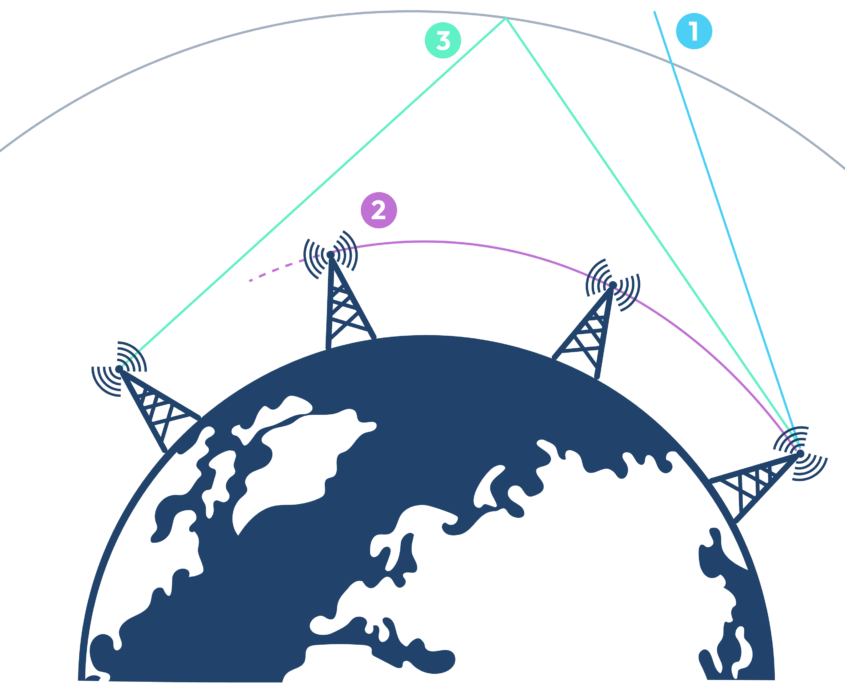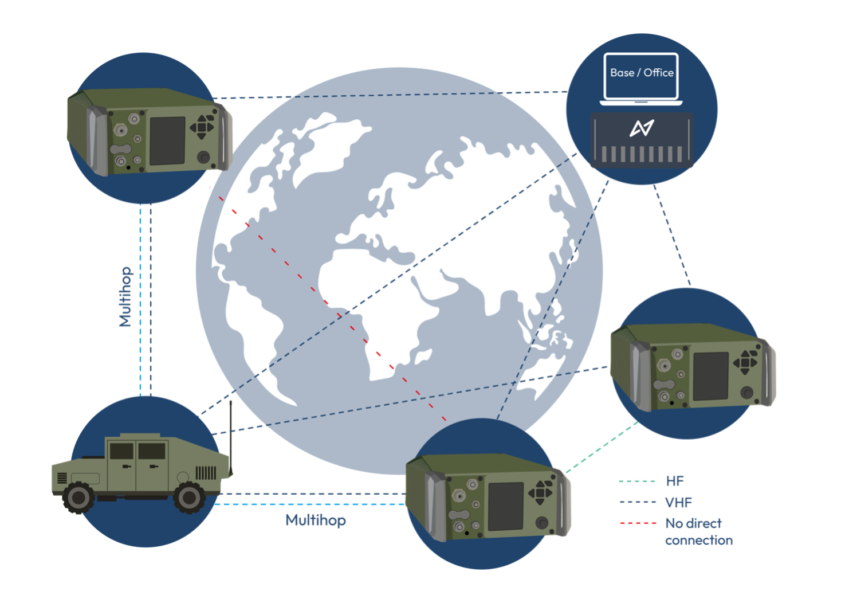Multihop – The easiest way to expand your range
Radio waves have traditionally provided an unbeatable way to stay connected in the air, on land or out at sea. At some point, however, the distance between the communicating parties might break and cause ultimately a complete loss of connection. KNL’s innovative wide band HF multihop technology closes that gap, guaranteeing the success of your operation.
Establishing a reliable radio connection is not a walk in the park
Creating a radio communication is easy when the transmitter and the recipient have a visual connection, electromagnetic waves can reach their counterpart usually without issues. Such connection is easier to establish if the transmitting HF antenna is on top of a sky-scraping radio tower, but the line of sight is often interrupted when communication happens between people or ships. In addition to other physical barriers, the Earth’s curvature presents a fundamental issue – if the two parties are too far apart, the signal cannot travel beneath the horizon.
When operating on different frequency ranges HF has huge advantages. It doesn’t need any infrastructure – no cables, no satellites. HF radio waves can easily proceed to the other side of the world by bouncing off the ionosphere. That eliminates geographical limitations, but how strong radio signal are, is depending on sun. When the Sun emits ionising radiation, it generally improves the ionosphere’s capability to strengthen radio signals. On the other hand, when there is less such activity, the signal skips less intensively. The Sun greatly impacts how well – or poorly – radio signals are propagated from the ionosphere.
HF technology has a reputation that it is unreliable and difficult to use because of multiple parameters affecting communications, like radio propagation and interference from other users thousands of kilometres away. We, at KNL, have proven this reputation wrong as our systems are easy to use!
How radio waves travel
- VHF, UHF (30-3000 MHZ): Very high frequency and ultra-high frequency radio travel directly in practically a straight line. UHF is used in mobile phones and televisions.
- LF, MF (0.03-3 MHZ): Low frequency radio waves travel following the contour of the Earth until it fades away.
- HF (3-30 MHZ): High frequency radio waves are reflected in the ionosphere. With HF radio waves the signal can easily proceed to the other side of the world.

Illustration of how different types of radio waves travel
Multihop changes the game – to your advantage
The future of dynamic radio communications should not be left to the activity of the Sun or whether the communication parties have line-of-sight or not. Defence situations and monitoring large geographical areas can change in an instant, and radio blackouts have no place in those moments.
At KNL, we are committed to delivering the most reliable communications solutions that are guaranteed to exceed your expectations in all conditions. Multihop technology brings advantages in CNHF radios.
Multihop technology in a nutshell
- Uses other multihop-enabled radios to relay a radio signal.
- The relays (multihop-enabled radios) automatically negotiate all necessary parameters, including choosing a frequency.
- Easy to connect, but incredibly secure and interference-free.
Read more about the basics of KNL’s CNHF radio and it’s ability to scan radio frequencies.

Illustration about how multihop operates
The absolute advantages of using multihop
- Stretches line-of-sight on VHF and decreases the silent zone (also known as skip zone) in HF.
- Doubles the surface wave range on HF
- Creating a multihop connection can be made under all circumstances – during defence, patrol, or combat.
- Does not depend on unforeseeable variables, such as the sun’s activity.
- Portability means flexibility – even individuals on the field can establish a multihop connection or act as a relay themselves.
Why multihop is the technology you should choose
Multihop on HF band is technological breakthrough but truly understanding its benefits will help you in leveraging its unrivalled benefits in the field.
While there are many ways in which multihop revolutionises your capability to maintain communication, here are some things we want to emphasise.
Capabilities at sea, land and at critical situations.
Cognitive radio leverages multihop for lightning-fast connectivity
Cognition is now a key part of radios. The most innovative cognitive communication systems in the world – the ones of KNL – can find the right frequency and set other parameters needed for smooth radio interaction by continuously analysing and adapting to the environment.
For example, when KNL’s cognitive radios are in multihop mode, the radios are immediately and automatically choosing a frequency that has the least users and interference and hence maximise the performance of the connection. However, if an actor with much higher transmission power occupies the frequency and interferes with communications, KNL’s radios immediately seek and adjust to a new frequency that has no users and little interference.
Automated network extension
The mere diversity of use cases that can be achieved with an advanced cognitive radio operating in multihop mode is impressive.
For example, placing a radio on an island offers the Navy capabilities to reliably communicate with ships that are operating around it, securely and without interference using surface wave as multihop doubles the surface wave range.
Reimagine the possibilities of radio communications with KNL
Are you ready to elevate your radio communications to the next stage of reliability, versatility, and speed? For further inquiries regarding KNL’s radios, reach out to our sales team.
